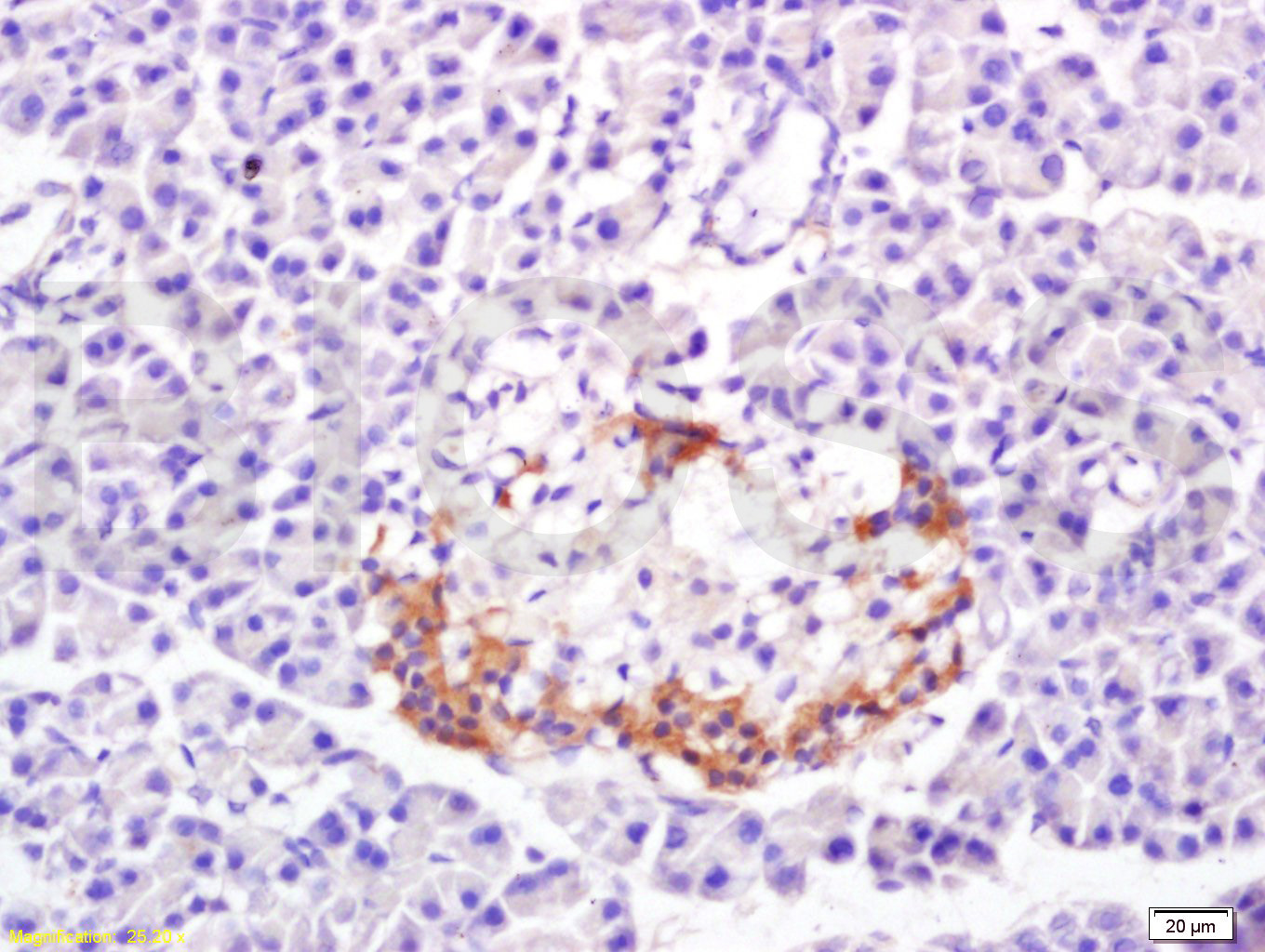
Mouse Anti-PP-1B antibody
Protein phosphates-1; PP-1 gamma, beta, alpha, catalytic subunit; MGC3672; PP 1B; PP-1B; PPP1CB; PP1B; PPP1CD; PP1beta; Protein phosphatase 1 beta; Protein phosphatase 1 catalytic subunit beta isoform; Protein phosphatase 1 delta; Serine threonine prot
View History [Clear]
Details
Product Name PP-1B Chinese Name 蛋白磷酸酯酶-1B抗体 Alias Protein phosphates-1; PP-1 gamma, beta, alpha, catalytic subunit; MGC3672; PP 1B; PP-1B; PPP1CB; PP1B; PPP1CD; PP1beta; Protein phosphatase 1 beta; Protein phosphatase 1 catalytic subunit beta isoform; Protein phosphatase 1 delta; Serine threonine protein phosphatase PP1 beta catalytic subunit; Serine/threonine-protein phosphatase PP1-beta catalytic subunit; PP1B_HUMAN; Protein phosphatase 1, catalytic subunit, beta isozyme; Protein phosphatase 1, catalytic subunit, delta isoform; Research Area Cell biology Neurobiology Signal transduction Apoptosis Kinases and Phosphatases Immunogen Species Mouse Clonality Polyclonal React Species Rat, (predicted: Human, Mouse, Cow, Horse, Rabbit, ) Applications ELISA=1:5000-10000 IHC-P=1:100-500 IHC-F=1:100-500 IF=1:100-500 (Paraffin sections need antigen repair)
not yet tested in other applications.
optimal dilutions/concentrations should be determined by the end user.Theoretical molecular weight 37kDa Cellular localization The nucleus Form Liquid Concentration 1mg/ml immunogen KLH conjugated synthetic peptide derived from human PP-1B: 155-250/327 Lsotype IgG Purification affinity purified by Protein A Buffer Solution 0.01M TBS(pH7.4) with 1% BSA, 0.03% Proclin300 and 50% Glycerol. Storage Shipped at 4℃. Store at -20 °C for one year. Avoid repeated freeze/thaw cycles. Attention This product as supplied is intended for research use only, not for use in human, therapeutic or diagnostic applications. PubMed PubMed Product Detail The phosphorylation and de phosphorylation of proteins on serine and threonine residues is an essential means of regulating a broad range of cellular functions in eukaryotes, including division, homeostasis and apoptosis. A geoup of proteins that are intimately involved in this process are the serine/ threonine protein phosphatases. The protein phosphatases (PP) holoenzyme is a trimertic complex composed of a regulatory subunit, a variable subunit and a catalytic subunit. Four major families of protein phosphatase catalytic subunits have been identified and are designated PP1, PP2A, PP2B (calcineurin) and PP2C. An additional protein phosphatase catalytic subunit, PPX or PP4, is the member of a potentially novel PP family. The PP1 family is composed of subfamily members PP1 alpha, PP1 beta,and PP1 gamma.The PP2A family iscomposed of subfamily members PP2A alpha,and PP2A beta. The PP2B family is composed of subfamily members PP2B-A alpha, PP2B-A beta and PP2B-A gamma. The PP2C family is composed of PP2C alpha, PP2C beta, PP2C gamma. Wip1, a protein isentified in the p53 DNA response pathway, has also been identified as a potential member of the PP2C family. Regulatary subunits include dnuclear inhibitor of PP1(NIPP1), PP2A-AAlphaand–A beta, PP2A-B alpha and B beta,PP2A-C alpha and C beta, PP2A-B56-alpha and–B56 beta, PR48 and PP2B-B1 and–B2.
Function:
Protein phosphatase that associates with over 200 regulatory proteins to form highly specific holoenzymes which dephosphorylate hundreds of biological targets. Protein phosphatase (PP1) is essential for cell division, it participates in the regulation of glycogen metabolism, muscle contractility and protein synthesis. Involved in regulation of ionic conductances and long-term synaptic plasticity. Component of the PTW/PP1 phosphatase complex, which plays a role in the control of chromatin structure and cell cycle progression during the transition from mitosis into interphase.
Subunit:
PP1 comprises a catalytic subunit, PPP1CA, PPP1CB or PPP1CC, which is folded into its native form by inhibitor 2 and glycogen synthetase kinase 3, and then complexed to one or several targeting or regulatory subunits. The targeting or regulatory subunits determine the substrate specificity of PP1. PPP1R12A, PPP1R12B and PPP1R12C mediate binding to myosin. PPP1R3A (in skeletal muscle), PPP1R3B (in liver), PPP1R3C, PPP1R3D and PPP1R3F (in brain) mediate binding to glycogen. Part of a complex containing PPP1R15B, PP1 and NCK1/2 (By similarity). Component of the MLL5-L complex, at least composed of MLL5, STK38, PPP1CA, PPP1CB, PPP1CC, HCFC1, ACTB and OGT. Interacts with PPP1R7 and PPP1R12C. PPP1R15A and PPP1R15B mediate binding to EIF2S1. Interacts with PPP1R16B. Component of the PTW/PP1 phosphatase complex, composed of PPP1R10/PNUTS, TOX4, WDR82, and PPP1CA or PPP1CB or PPP1CC. Interacts with PPP1R8. Interacts with TRIM28; the interaction is weak. Interacts with PPP1R12A and NUAK1; the interaction is direct.
Subcellular Location:
Cytoplasm. Nucleus. Nucleus, nucleoplasm. Nucleus, nucleolus. Note=Highly mobile in cells and can be relocalized through interaction with targeting subunits. In the presence of PPP1R8 relocalizes from the nucleus to nuclear speckles.
Similarity:
Belongs to the PPP phosphatase family. PP-1 subfamily.
SWISS:
P62140
Gene ID:
5500
Database links:Entrez Gene: 5500 Human
Entrez Gene: 19046 Mouse
Omim: 600590 Human
SwissProt: P62140 Human
SwissProt: P62141 Mouse
Unigene: 591571 Human
Unigene: 702907 Human
Unigene: 241931 Mouse
Unigene: 456635 Mouse
Unigene: 128769 Rat
Unigene: 39034 Rat
Product Picture
Antigen retrieval: citrate buffer ( 0.01M, pH 6.0 ), Boiling bathing for 15min; Block endogenous peroxidase by 3% Hydrogen peroxide for 30min; Blocking buffer (normal goat serum,C-0005) at 37℃ for 20 min;
Incubation: Anti-PP-1B Polyclonal Antibody, Unconjugated(SL0133M) 1:300, overnight at 4°C, followed by conjugation to the secondary antibody(SP-0024) and DAB(C-0010) staining
Bought notes(bought amounts latest0)
No one bought this product
User Comment(Total0User Comment Num)
- No comment



 +86 571 56623320
+86 571 56623320
 +86 18668110335
+86 18668110335

